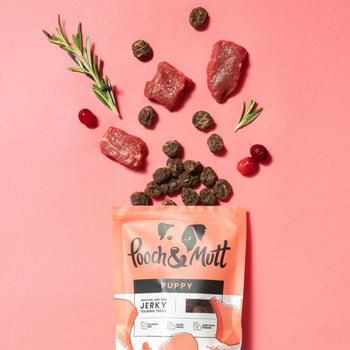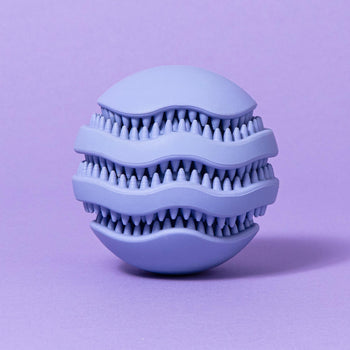As a new puppy owner, you’ve taken on the role of puppy carer, trainer, and mum or dad! Your new pup now relies on you for everything - from getting their dinner to helping them become their best puppy self.
As your new partner in crime, it’s understandable that the first time they spend away from you can be difficult. Whether you’ve left the room or left them to sleep for the night, they may display signs of separation anxiety.
A common thing for young puppies to experience, separation anxiety can be approached in the same way as any behavioural issue - with lots of care, patience and training. Nipping it in the bud early helps to avoid it sticking around in adulthood, where it’s harder to tackle.
That said, we’re here to clue you up on all things separation anxiety, and what you can do to help prevent it.
What is separation anxiety?
When some puppies or dogs are left alone, their anxiety and fear can lead to problematic and destructive behaviour. Separation anxiety is very common in young puppies, and if not tackled can affect dogs in adulthood.
Puppy training for separation anxiety
The best way to tackle separation anxiety is with preventative training.
Young puppies are instinctively going to be a little bit nervous when they first start being left on their own, so working on making them feel safe, even when mum or dad is not in the room, is imperative!
But how do you approach separation anxiety for your puppy?
Preparing for separation anxiety training
Preventative training for separation anxiety in puppies requires not only the right approach, but also the right preparations.
Here are a few things you can do to prepare for separation anxiety.
-
Investing in a puppy gate/crate/pen to create their own space. This way, you can easily create a separate area for your puppy that you can ensure is safe.
Not only will they be cut off from anything that could cause them harm when unsupervised, but their own little space can help them feel safe and secure - especially when you fill it with cosy blankets! You can also lay down temporary toilet pads if toilet training is still going on.
When it comes to eventually leaving them for extended periods, it’ll help you do so with peace of mind.
-
Installing a puppy cam. Consider installing a puppy camera! Many on the market come with an app that can be downloaded onto your phone and allows you to tune into the live puppy cam, wherever you are. This can also help you detect signs of separation anxiety when you’re not in the room, to aid training.
-
Stocking up on treats. The key to any successful training is high-reward treats! For younger pups, you’ll have to stock up on treats suitable for tiny tums. For puppies over 12 weeks, you have the pick of our entire Meaty Treat range, perfect for gaining your pup’s focus and rewarding good behaviour.
-
Allowing your puppy to be independent. As they really put those puppy eyes to work, it’s hard to not want to carry them around all day. But allowing your pup to be independent sometimes, and not so reliant on you, will help them manage to be on their own.
-
Utilising music and sound. Studies show that music has an impact on dogs, and can help them settle. Try keeping the radio on whilst you’re tiring them out to get them accustomed to the sound, and then leave it on as you practice leaving them on their own. Better yet, why don’t you try out our very own relaxing Pooch Playlist?
-
Tackling toilet training. Toilet training should come before separation anxiety training to help avoid any accidents. They should also be old enough to hold their pee and poop for an extended amount of time when you begin leaving them home alone.
-
Mapping out your approach. Like most training, preventative separation anxiety training requires a gradual approach.
This might include leaving the room for increasing increments of time, repeating the process when they’re able to be left home alone and perhaps going back a couple of steps if they’re struggling to catch on.
Preventative separation anxiety puppy training: Step-by-step
The main aim of preventative separation anxiety training is to desensitise your pup - getting them accustomed to being on their own, without inducing fear, anxiety or destructive behaviour.
Like any training, this takes lots of patience, practice and dedication. But with the right approach, you should end up with an adult dog who’s an all-around angel when temporarily left alone!
If you’re amidst puppy training and looking to tackle separation anxiety, think about taking the following steps:
1. Creating a puppy-safe space. If your pup’s been home with you for a few weeks now, they should already have a little space to call their own. This helps them feel safe and secure, and gives them a place to escape to when things get a little too much!
When creating a space for your pup, remove anything they could chew or choke on, and block off any areas where they could get into mischief. This is where playpens, crates or puppy gates come in handy.
2. Tiring them out beforehand. Before starting the training, spoil them with lots of play and attention! This will tire them out, and help them settle.
If you’ve opted for music or the radio to keep your pup company, you could try putting this on now to get them used to it - and help them associate it with something positive.
3. Make sure they’ve had the opportunity to pee and poop! This is to avoid any accidents when they’re on their own, and to get them into the routine of going before you leave. This way, when they’re older, you can ensure they’ve done their business before you leave them for an extended amount of time.
4. Giving them a treat or a distraction. Once they’re all tuckered out and you’re ready to start the training, pop them in their space with plenty of puppy-safe distractions.
Avoid anything they could chew, tear and rip whilst alone, and maybe focus on lick mats or treat stuffers - something that’ll keep them entertained and distracted whilst you temporarily leave them.
Leaving the room for 5 minutes. When your pup’s all nice and settled in their space, and they’ve got something to distract their attention, you can try leaving the room. Keep this short and sweet at first, and try to listen out for their reaction.
Try not to rush to them at the first sign of stress (whether that’s a howl or a whine) but at the same time, be sure not to leave them to get too worked up, as this may make training harder.
6. Don’t make a fuss when you return. When you do decide to return, whether that’s if they’re getting too stressed or your time is up, try not to make a big fuss of them. Enter the room calmly, maybe taking your time to address them.
The sight of you will already calm them down, so you could take this opportunity to wait for them to be completely settled, or distracted by a treat, before you direct your attention back to them.
7. Increase the amount of time you leave the room. Once you’ve had a couple of goes of leaving the room for five minutes or so, and your pup’s responding well, you could consider lengthening the time. Maybe try leaving them for 10 minutes, then 15 - gradually increasing the time and continuing to monitor their reaction and behaviour.
8. Continue this until they’re old enough to be left home alone. This training can continue as your puppy grows, and when they reach 3 months and older, you can move on to leaving the house, not just the room.
The same gradual approach should be taken to this form of training where you start leaving them for a short amount of time, 5 or 10 minutes, gradually increasing it.
9. Leave the house normally, setting the routine. When starting this gradual desensitisation, you shouldn’t stray away from your usual routine. Allow your puppy to recognise the signs like putting shoes on, popping the radio on, giving them a treat, or jangling keys - and help them know that they’re still safe and secure.
Where we advise not to make a big fuss when you come home, try not to make a big fuss when you’re leaving either! As much as it’s hard to ignore their inquisitive head tilts and puppy dog eyes, they won’t find it rude if you don’t say your goodbyes. Just go on about your business and let them observe.
Lengthening the time you’re away from the house. Once you’ve tested the water with some short outings, you can begin increasing the time you’re away from the house.
With the help of puppy cams and helpful neighbours, you can monitor how your pup’s taking it. If after their first couple of long stints of time alone, they’re still showing signs of anxiety, try starting again by leaving them for shorter amounts of time.
After time, and a lot of patience, your pup should realise that being left alone isn’t all that scary and that mum and dad will always come back
Why do puppies get anxious on their own?
Before your puppy comes home with you, they’re never on their own!
From the breeders, their littermates, and their mum - they’re going to be used to a very busy household. Plus, dogs are naturally very social creatures - they like to be in their pack.
Once they come home with you, they’re already a little frightened and apprehensive of their new home and environment, so they’re going to want to stay where they feel safe and protected - with you! Temporarily take that away, and puppy panic can set in.
What are the signs of separation anxiety in puppies?
There are many tell-tale signs of separation anxiety in puppies that take place when left alone, including:
- Howling, barking and whining
- Chewing and destruction of surroundings
- Shaking and panting
- Pacing
- Peeing or pooping
How do you know if your puppy has separation anxiety?
Since these symptoms take place when left alone, you may be thinking, how do you spot the signs of separation anxiety?
There are a couple of ways to see if your puppy is suffering from separation anxiety after you leave them alone:
-
Testing them. The first step in tackling separating anxiety is seeing how your puppy fairs on their own. This can involve setting up a puppy-safe space and then leaving the room. This way, you can listen out for their reaction.
-
Setting up a camera. Whether you’re testing the waters by leaving the room, or leaving them on their own for the first time, setting up a camera will allow you to keep an eye on their behaviour when you’re not there, and help you spot the signs.
-
Asking the neighbours. If you’re trialling leaving your puppy alone for the first time or starting your preventative separation anxiety training, it’s good courtesy to let your neighbours know. This is so you can warn them of any potential noise, but also to ask them to listen out for any noise whilst you're gone.
At what age can you leave a puppy alone?
When it comes to any type of training, starting young does help the process along.
However, when it comes to starting preventative separation anxiety, it’s important to remember that puppies under 3 months old should not be left alone.
For puppies older than 3 months, they can gradually be introduced to being left home alone, but in a safe environment where they can’t get in harm’s way.
How long can you leave a puppy alone?
The length of time a puppy can be left on their own depends on their age, temperament and level of training.
Where puppies under 3 months shouldn't be left alone at all, older pups can learn to be by themselves through gradual training - building up from you temporarily leaving the room, to leaving the house entirely.
The rule of thumb is that puppies under 6 months shouldn’t be left alone any longer than 2 hours. Then, you should consider how long they can hold their pee and poop, which is typically an hour for every month of their age.
All of this should be taken into consideration before the home-alone trials start.
If you’re looking for more tips on shaping your new puppy to be the best dog they can be, be sure to check out the rest of our Puppy Hub! Packed with helpful tips, tricks and guides, we’ve got you new puppy pawrents covered. As well as training, our range of Puppy wet and dry food means their diet is sorted too. Specially formulated for little developing puppy tums, you can guarantee they’re starting life with their best paw forward.
















Comments (0)
Leave a comment